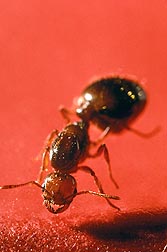This page has been archived and is being provided for reference purposes only. The page is no longer being updated, and therefore, links on the page may be invalid.
| Read the magazine story to find out more. |
|
|
|
|
Researchers Study Fire Ant Venom as Natural Fungicide
By Jan SuszkiwAugust 2, 2013
Red imported fire ants are named for the fire-like burn of their sting. Now, the same venom that packs such a painful wallop may actually do some good for a change.
Studies by U.S. Department of Agriculture (USDA) scientists in Stoneville, Miss., have shown that certain alkaloid compounds in the venom—piperideines and piperdines—can hinder the growth of the crop pathogen Pythium ultimum.
Chemical fungicides, delayed plantings and crop rotation are among methods now used to control P. ultimum, which causes damping-off diseases that decay the seed or seedling of vegetable, horticultural and cucurbit crops. Despite such measures, damping-off remains a costly problem, and new approaches are needed, according to Jian Chen, an entomologist with USDA's Agricultural Research Service (ARS). ARS is USDA's chief intramural scientific research agency.
Chen is coinvestigating the potential application of fire ant venom to manage soilborne pathogens like P. ultimum in collaboration with ARS microbiologist Xixuan Jin, and Shezeng Li of the Institute of Plant Protection in Baoding, China.
For their studies, conducted at the ARS Biological Control of Pests Research Unit in Stoneville, the researchers used sophisticated extraction techniques to obtain purified amounts of piperideine and piperidine from the venom glands of both red and black imported fire ants, which are considered invasive pests and a dominant species on more than 320 million acres in the South as well as in other states and Puerto Rico.
In petri dish trials, the researchers exposed P. ultimum's threadlike growth form, called "mycelium," to various concentrations of the alkaloids and monitored the effect on the pathogen's colony size. Its spore-forming structures, called sporangia, were similarly exposed.
The results, reported in the December 2012 issue of Pest Management Science, include significant reductions in the growth and germination of the pathogen's mycelium. Both alkaloids performed equally well and retained their activity against P. ultimum for up to 12 weeks when stored at room temperature. Additionally, more than 90 percent of sporangia failed to germinate when exposed to the alkaloids at concentrations of 51.2 micrograms per milliliter.
Synthetic versions of the alkaloids, called "analogs," have also inhibited several cultured human fungal pathogens.
Read more about this research in the August 2013 issue of Agricultural Research magazine.

